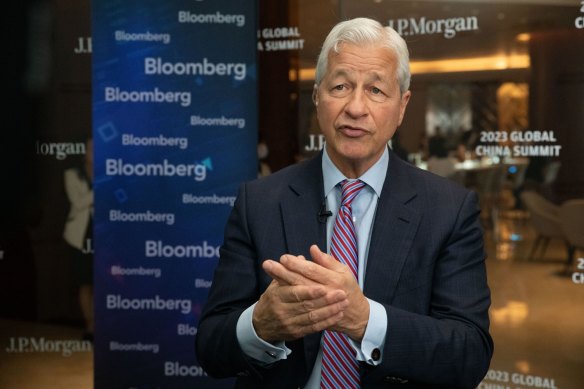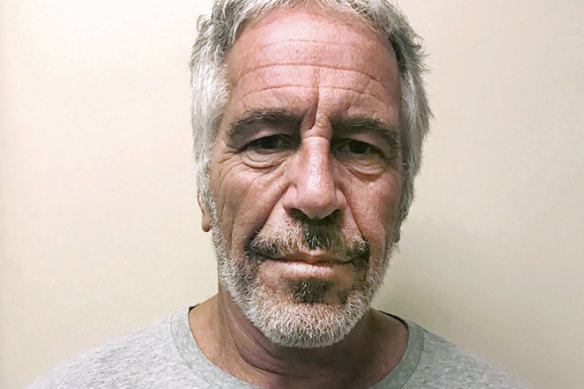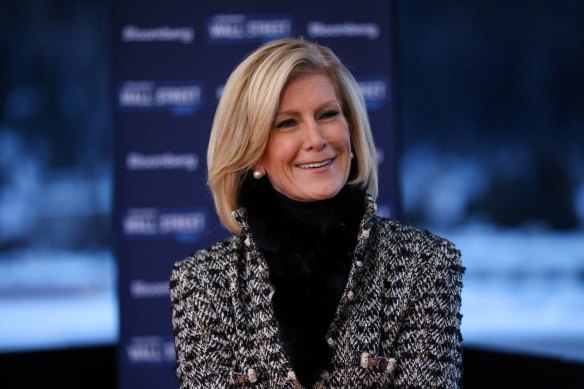This was published 1 year ago
Inside JPMorgan’s year of being haunted by Jeffrey Epstein
By Hannah Levitt and Ava Benny-Morrison
Jamie Dimon wasn’t going to be embarrassed into a settlement. As damaging revelations about the extent of JPMorgan Chase & Co.’s relationship with Jeffrey Epstein trickled out of a lawsuit this year, his bank balked at paying up.
The longtime JPMorgan chief told colleagues he saw the fight as one of “principle.” He and others within the bank viewed the plaintiff — the US Virgin Islands, where Epstein had a private island — not as a victim, but instead complicit in the deceased sex offender’s crimes.

“I am so sad that we had any relation to that man whatsoever.“: JPMorgan chief Jamie Dimon.Credit: Bloomberg
From the moment a year ago when the firm’s top brass was surprised to learn that the territory would be pursuing a claim, through months of USVI attorneys taking aim first at Dimon and then one of his top deputies, JPMorgan’s leaders were forced to weigh the legal, reputational and emotional concerns of the case. All the while, contents of old emails spilled into public view, chronicling years of close ties to one of this era’s most notorious sex offenders.
Ultimately, the $US75 million ($117 million) JPMorgan agreed to pay the USVI this week is a tiny number for the firm, which generates that much in revenue in about five hours. Even combined with the $US290 million settlement it reached with Epstein’s victims in June, the total cost barely moves the needle for the biggest and most profitable bank in American history.
JPMorgan’s combative approach with the US Virgin Islands led to it settling for a quarter of what the territory had sought in earlier talks. But it’s also left the firm seeking to tally the ultimate damage of its year of being haunted by Epstein — a decade after ejecting him as a client and four years after his death in a Manhattan jail cell — from which almost no one involved emerged unscathed.
This account is based on interviews with more than half a dozen people close to the case, who asked not to be identified discussing private matters, as well as court documents and other filings. A JPMorgan representative declined to comment.
“The undisputed facts about JPMorgan Chase’s relationship with Jeffrey Epstein are now publicly available,” Venetia Velazquez, a spokesperson for the US Virgin Islands Department of Justice, said in an emailed statement.
“The USVI DOJ is pleased JPMorgan Chase has made meaningful commitments to establish and implement measures to combat human trafficking as part of the precedent-setting settlement agreement.”
Subpoenaed emails
Details of JPMorgan’s banking relationship with Epstein began to emerge around the time he died in August 2019. As government entities dug deeper into Epstein’s sex-trafficking operation, executives at New York-based JPMorgan saw an increasing likelihood of being pulled into litigation.
But they didn’t think that would include a lawsuit from the USVI, where Epstein had a private island and trafficked some of his victims. That was until a meeting last September, during which USVI officials laid out investigative findings against JPMorgan to its lawyers. Armed with troves of emails the territory had already obtained through subpoenas, it sued in December and quickly began going after some of JPMorgan’s highest-ranking officials — starting with the CEO.

Details of JPMorgan’s banking relationship with Epstein began to emerge around the time he died in August 2019.Credit: AP
The USVI initially sought to show that Dimon, 67, was involved in decisions around Epstein’s accounts. It cited an internal email from 2008, the year Epstein pleaded guilty to soliciting a minor for prostitution, where a staffer predicted Epstein’s assets would leave the bank that year “pending Dimon review.”
In response to the February filing, JPMorgan said it had seen no evidence of such a review. The firm’s lawyers fought the plaintiffs’ requests to depose Dimon, but he eventually set aside two days for questioning under oath.
Over seven hours in late May — three years to the day after the USVI first subpoenaed JPMorgan in its case against Epstein’s estate — Dimon repeatedly said that he never met or emailed Epstein and wasn’t involved in decisions over his account. Afterward, JPMorgan even agreed to release the transcript.
Public sympathy
Behind the scenes, mediation talks that had begun earlier that month were ongoing. Those resulted in JPMorgan’s agreement in June to pay $US290 million to the victims, who sued the bank in November. Some executives saw the claims as meritless, while others favored a quick settlement to acknowledge the victims’ suffering and end the chapter in the saga that garnered the most public sympathy.
JPMorgan’s battle with the USVI, however, was a different story. Their talks fell apart when the territory demanded a $US300 million settlement, so the bank pressed ahead with its fight.
By that time, JPMorgan was also pursuing claims of its own against Jes Staley, its former private-banking chief whose close relationship with Epstein was central to both cases against the bank. The firm accused him of concealing an “inappropriate relationship” with Epstein and vouching for his character to keep him on as a client. JPMorgan and Staley also reached a settlement this week, for undisclosed terms.

JPMorgan has repeatedly credited Mary Erdoes with firing Epstein as a client in 2013, but, as the cases dragged on, both the USVI and Staley pointed to her many messages with him over the years to show the bank’s culpability.Credit: Bloomberg
That’s when Mary Callahan Erdoes, JPMorgan’s longtime asset- and wealth-management head, found herself in the crossfire. Lawyers for the USVI seized on her old missives with Epstein, as well as the fact that he was a client of her division for so long. JPMorgan’s shortcomings were institutional, it argued, rather than the fault of one “bad apple.”
Erdoes, 56, rose through JPMorgan’s private bank to become its chief in 2005, succeeding Staley, her mentor at the time. When Staley, 66, was tapped to lead the investment bank in 2009, he recommended Erdoes as his replacement, and she got the job — one she still holds today.
JPMorgan has repeatedly credited Erdoes with firing Epstein as a client in 2013, but, as the cases dragged on, both the USVI and Staley pointed to her many messages with him over the years to show the bank’s culpability.
So for Erdoes, the drip-drip continued. She was deposed twice this year, and, until the resolutions this week, the possibility lingered that she might be called to testify at trial. Even now, colleagues are privately contemplating the ultimate impact for Dimon’s longest-serving deputy. The CEO has supported her throughout the process.

JPMorgan accused former private banking chief Jes Staley of concealing an “inappropriate relationship” with Epstein and vouching for his character to keep him on as a client.Credit: AP
‘So sad’
The cases also cast a shadow beyond JPMorgan’s four walls. Steve Cutler, the bank’s former general counsel, and Catherine Keating, who led the firm’s US private bank more than a decade ago and now runs wealth management at Bank of New York Mellon Corp., both faced depositions of their own and saw their old emails made public.
Paul Barrett, a former JPMorgan banker who joined Citigroup in 2019, left that bank days after an April report that he scheduled at least five meetings with Epstein between 2014 and 2017. At the time, a Citigroup spokesperson confirmed Barrett was no longer an employee and said that “until recently, Citi was unaware of Paul Barrett’s association with Jeffrey Epstein.”
Goldman Sachs General Counsel Kathy Ruemmler grappled with renewed scrutiny of her past professional dealings with Epstein, which she has said she regrets and told her firm about when she joined in 2020. Even Elon Musk was served a subpoena, which he called “idiotic,” denying that Epstein ever advised him.
In the end, while the lawsuits were one of the worst public episodes in Dimon’s almost 18 years atop JPMorgan, he personally came through it with little harm to his reputation. The outspoken CEO was unusually mum on the cases at first, declining to comment on ongoing litigation, but he switched tactics to an increasingly robust apology as the cases dragged on.
“I am so sad that we had any relation to that man whatsoever,” Dimon said in a Bloomberg Television interview in early May, ahead of his deposition. “It’s very unfortunate and I have deep respect for these women. That doesn’t mean we’re liable for the action of an individual, but I do have deep respect for them and my heart goes out to them.”
Bloomberg
The Business Briefing newsletter delivers major stories, exclusive coverage and expert opinion. Sign up to get it every weekday morning.